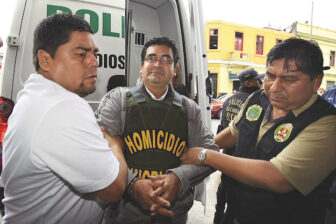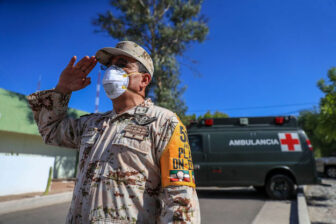This article is adapted from AQ’s special report on transnational organized crime | Ler em português | Leer en español
In the vast expanse of the Eastern Pacific, near the Central American isthmus, a lone semisubmersible vessel transits westbound, loaded with several tons of cocaine. Its low, partially submerged profile is nearly imperceptible to the human eye. The four-person crew’s job is to get a massive cocaine shipment as close to the U.S. as possible, before handing it over to the next link in the narco-trafficking chain.
U.S. Navy and Colombian Air Force maritime patrol aircraft pinpoint the vessel’s location, track its movements, and share its projected path with authorities from a nearby Central American country positioned to intercept the shipment. The partner country dispatches a maritime interceptor to close in on the vessel.
The semisubmersible crew makes a desperate attempt to evade the incoming interceptor, but the interceptor crew spots their vessel. It is game over for the drug smuggling crew and the end of the road for their cocaine shipment.
This story is based on similar disruptions successfully carried out during counter-narcotics operations led by the U.S. military’s Southern Command (SOUTHCOM), working closely with more than 20 nations and 16 interagency partners — a collaboration that has led to a 65% increase in targeting of maritime cases.
In the wake of the COVID-19 pandemic, transnational criminal organizations (TCOs) have adjusted their tactics, techniques and procedures. Use of commercial fishing vessels and shipping containers in cocaine transport has decreased and they have increasingly employed smaller, semisubmersible vessels instead. Their use of Western Caribbean transit routes also increased in response to travel and shipping restrictions. Every country has to be at the top of their game to counter this threat.
The TCOs operating in the Americas compete for the estimated $94 billion generated annually by cocaine trafficking worldwide. They will exploit any technology, opportunity or vulnerability, going as far as corrupting government, judicial and law enforcement officials to undermine institutions entrusted with public security. TCOs respect no borders or rule of law and operate with agility and innovation. This requires the U.S. government to operate as one entity — across multiple agencies — and cooperate across international boundaries.
Countering TCOs is a national security and defense imperative and is critical to the homeland defense of the United States. Whole-of-hemisphere cooperative security approaches and strong security institutions, which share values and ensure security, prosperity and freedom, are vital.
Vicious Circle of Threats
Transnational criminal organizations will spare no idea or tactic to smuggle cocaine and other dangerous drugs. During the 2018 World Cup tournament, Argentine authorities seized World Cup trophy replicas, each containing approximately 1.5 kilos of cocaine. In 2019, Spanish law enforcement authorities interdicted a semisubmersible vessel loaded with 3.5 metric tons of cocaine off the Iberian Peninsula’s northwestern coast. Earlier that year, news reports described how Cape Verde law enforcement authorities seized 9.5 metric tons of cocaine aboard a Russian vessel en route from South America to Morocco.
These global cocaine trafficking networks pose a significant threat to the health of people, the environment and economies. The harmful substances and chemicals used to manufacture cocaine hydrochloride include ammonia, methyl ethyl ketone, sulfuric acid and gasoline. Cocaine laboratories recklessly release these chemicals into the environment. Cocaine users ingest these chemicals, often unaware of the full extent of consequences to their health. Some drug dealers lace cocaine with fentanyl, a synthetic opioid analgesic that is similar to morphine, but 50 to 100 times more potent. The result is a cheaper but more powerful and potentially fatal cocaine high.
There are financial threats as well. Businesses created as front companies to launder criminal fortunes undermine legitimate commerce and trade. Chinese professional money-laundering networks have in recent years emerged as key service providers in the region, capable of moving large amounts of drug proceeds quickly through international trade.
Every time they engage in illegal activity, criminal and violent extremists undermine the rule of law and contribute to a spiral of instability, which, exacerbated by violence and COVID-19, fuels levels of corruption, weak institutions, and fragile states that strain social and legal systems and trigger migrations. The result is a vicious circle of threats that threatens the security of our shared neighborhood. Defending it requires a whole of government and all domain approach; as well as a cooperative effort between partner nations. Intelligence sharing and overall coordination are absolutely essential.
What began in 1989 as a U.S. military joint task force charged with supporting law enforcement-led counter-narcotics operations in the Caribbean, the Joint Interagency Task Force-South (JIATF-South), a component of SOUTHCOM, has since become a model for interagency and international counter-narcotics cooperation.
Today, 16 U.S. federal agencies support the task force’s mission to monitor, detect, track and report air and maritime illicit trafficking. Their efforts support and enable law-enforcement counter-narcotics successes in an operating area that encompasses 42 million square miles, extending from the Eastern Pacific to the Western Atlantic and from international waters north of the Caribbean Antilles to the waterways south of the Cape Horn territorial boundary.
The U.S. Coast Guard, Customs and Border Protection, Drug Enforcement Administration, U.S. State Department, U.S. Agency for International Development and U.S. Defense Department are among the many U.S. federal agencies assisting countries seeking to dismantle transnational criminal organizations operating within their national territories.
This cooperation is effective. According to the UN Office on Drugs and Crime, the Americas accounted for 85% of total cocaine seized globally in 2018. And, despite the domestic demands created by COVID-19, our partners remain committed to the counter-narcotics fight. In the first six months of SOUTHCOM’s counter-narcotics operations, partner nations have participated in 60% of disruptions.
From Mexico to Brazil, and from Canada to Chile, our partners in the Western Hemisphere have contributed in varying ways to results achieved during SOUTHCOM’s counter-narcotics operation and Colombia’s Orion V counter-narcotics operation. From April through November, these combined efforts disrupted and seized more than 226 metric tons of cocaine, a loss of nearly $6 billion in profits for illicit narcotics trafficking networks. During that same period, the operations netted the detention of at least 520 suspected drug smugglers and are credited with saving an estimated 2,300 lives.
The increased participation of partner nation security forces is made possible through continued U.S. investment through Department of Defense (DOD) authorities, such as Title 10, Section 333, which permits the DOD to train and equip our partners with critical capabilities to counter illicit trafficking and increase border and maritime security. Sustained U.S. engagement supports partner capabilities ranging from improved riverine capability to disrupt narco-trafficking deep inside source zones in South America, to increasing partner nation aerial reconnaissance capability and maritime interdiction throughout Central America and the Caribbean, thus creating a dense network to disrupt transnational criminal organizations.
And many of these committed nations are increasingly investing in expanding or modernizing their counter-narcotics capabilities and contributing more to international counter-narcotics operations.
Jamaica and Costa Rica have purchased maritime patrol aircraft, Trinidad and Tobago and Ecuador have thwarted attempts by transnational criminal organizations to smuggle drugs in or near their territories. El Salvador’s naval forces are patrolling deeper into the Eastern Pacific, while Guatemala’s security forces are working in concert with counterparts from the U.S., Colombia, Mexico and other Central American nations to disrupt cocaine transported via illicit trafficking flights.
All counter-narcotics efforts by nations and government agencies support a common goal: to defend the security of our shared neighborhood by detecting, degrading and dismantling the transnational criminal organizations. To succeed, we need to continue to build on our strong partnerships with U.S. interagency and partner nations, through information sharing, data-based analysis and assessments, and synchronized targeting of TCOs. Only then we will be able to illuminate, map and dismantle the networks behind a global narcotics-trafficking enterprise contributing to roughly 450,000 annual drug-use-related deaths, according to the UN.
Transnational criminal organizations are innovative and highly adaptable and use a well-funded global network. We know that TCOs will continue to try to move unseen through porous borders, oceans and airways — but they will have to avoid detection and apprehension by a coalition of counter-drug nations, defending their citizens from the scourge of corruption, violence and death that accompanies the illicit drug trade.
__
Rear Admiral Tiongson is SOUTHCOM’s director of operations








